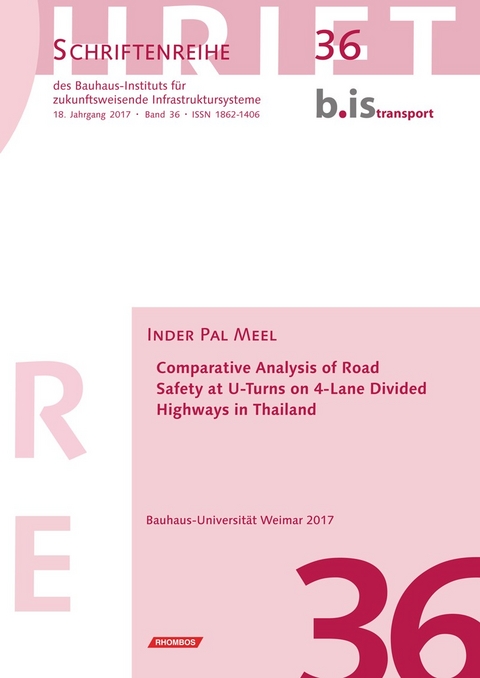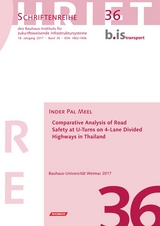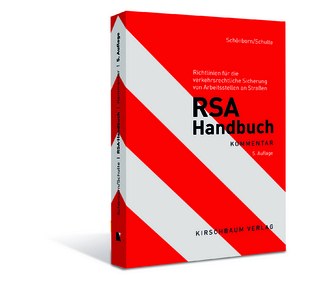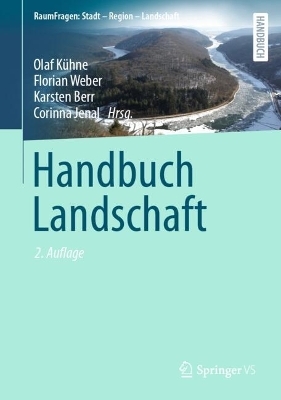COMPARATIVE ANALYSIS OF ROAD SAFETY AT U-TURNS ON 4-LANE DIVIDED HIGHWAYS IN THAILAND
Rhombos-Verlag
978-3-944101-45-3 (ISBN)
The Challenge and Opportunity
Thailand is an emerging country, highly motorised and is among the countries having a high death rate due to road traffic injuries. Each crash entails economic cost, not to mention the social cost of pain, grief, and suffering of families of the victims. It also has an adverse impact on the resources of the government.
To access road safety level and to improve safety strategies, the road crash data management system (reporting, recording and analysis) is the primary key. The current evolution status of Thai road crash data system is almost at the beginning phase and has been suffering from the issues of availability, reliability and quality. Therefore, it is utmost necessary to accelerate the process of the evolution of crash data management system. About 3 to 5 decades ago, the high-income-countries also encountered similar challenges and, it took a long time and several phases of evolution to develop a robust, capable and reliable crash data management system. The transfer of experience, knowledge and technology from the high-income-countries to Thailand could not be only a good option to save time, evolution phases and valuable resources, but also it is important to save the valuable human lives by early planning and execution of reliable and effective road traffic safety strategies.
For this study, an alternative, surrogate, subjective to human judgement and challenging approach was adopted due to the above mentioned issues of the road crash data management system in Thailand.
Keywords: Accident (traffic), Accident outcome, Accident risk, Collision, Conflict observation, Conflict point, Conflict zone, Conflict severity, Crash, Evasive action/maneuver, Event severity continuum, Hourly Conflict Rate, Injury accidents, Light traffic conflict, Loon, Median, Near-accident, Non-serious conflict, Police reported accidents, Post-Encroachment Time (PET), Required braking rate (RBR), Safety, Safety hierarchy, Serious conflict, Severity hierarchy, Shoulder, TCT (Traffic Conflicts Technique), Time-to-Accident (TA), Time-to-Collision (TTC), Traffic conflict, Traffic safety, Upstream, Validity
Zum Buch:
The Challenge and Opportunity
Thailand is an emerging country, highly motorised and is among the countries having a high death rate due to road traffic injuries. Each crash entails economic cost, not to mention the social cost of pain, grief, and suffering of families of the victims. It also has an adverse impact on the resources of the government.
To access road safety level and to improve safety strategies, the road crash data management system (reporting, recording and analysis) is the primary key. The current evolution status of Thai road crash data system is almost at the beginning phase and has been suffering from the issues of availability, reliability and quality. Therefore, it is utmost necessary to accelerate the process of the evolution of crash data management system. About 3 to 5 decades ago, the high-income-countries also encountered similar challenges and, it took a long time and several phases of evolution to develop a robust, capable and reliable crash data management system. The transfer of experience, knowledge and technology from the high-income-countries to Thailand could not be only a good option to save time, evolution phases and valuable resources, but also it is important to save the valuable human lives by early planning and execution of reliable and effective road traffic safety strategies.
For this study, an alternative, surrogate, subjective to human judgement and challenging approach was adopted due to the above mentioned issues of the road crash data management system in Thailand.
Keywords: Accident (traffic), Accident outcome, Accident risk, Collision, Conflict observation, Conflict point, Conflict zone, Conflict severity, Crash, Evasive action/maneuver, Event severity continuum, Hourly Conflict Rate, Injury accidents, Light traffic conflict, Loon, Median, Near-accident, Non-serious conflict, Police reported accidents, Post-Encroachment Time (PET), Required braking rate (RBR), Safety, Safety hierarchy, Serious conflict, Severity hierarchy, Shoulder, TCT (Traffic Conflicts Technique), Time-to-Accident (TA), Time-to-Collision (TTC), Traffic conflict, Traffic safety, Upstream, Validity
Contents
Acknowledgments i
Table of contents ii
List of Tables vii
List of Figures x
Glossary of Terms xi
1 Introduction 1
1.1 General Background 1
1.2 Function of U-turns on Thai Highways 3
1.3 Need for the Study - RoSCoE 3
1.3.1 Road Safety at U-turns 4
1.4 Road Safety Measurement and Analysis 8
1.4.1 Crashes Based Safety Analysis 8
1.4.2 Near-crash Events as an Alternative Approach 9
1.4.3 Traffic Conflict Technique (TCT) 10
1.5 Pilot Study: Thai Crash Data Management System 11
1.6 Research Objectives 11
1.7 Scope of Study 12
1.8 The State of Science 13
1.9 Outline of the Thesis 14
1.10 Research Approach and Design 15
2 Literature Review 16
2.1 General 16
2.2 Road Safety and Socio-economic Costs 16
2.3 Safety at Thai U-turns 17
2.4 Layout Designs of U-turn and Road Safety 18
2.4.1 Spacing of Median Openings 18
2.4.2 Classification of U-turns, their Advantages and Disadvantages . 18
2.4.3 Median Acceleration Lanes 23
2.4.4 Loons or Outer-widening 24
2.5 Road Safety Measurement Using Historical Crash Data 24
2.5.1 Road Safety Analysis and Crash Costing 24
2.5.2 Limitation of Using Historical Crash Data 27
2.6 Traffic Crash Data: Availability, Quality and Reliability 28
2.7 Surrogate Safety Measures 31
2.7.1 Traffic Conflict Techniques (TCT) as an Alternative Approach . 32
2.7.2 Traffic Event Hierarchy 35
2.7.3 Validity and Reliability of TCT 36
2.8 Traffic Conflict Indicators and Severity Measurement 38
2.8.1 Time to Accident / Speed (TA/Speed) 38
2.8.2 Time To Collision (TTC) 39
2.8.3 Post Encroachment Time (PET) 40
2.8.4 Strengths and Weaknesses of Conflict Indicators 41
2.9 Severity of Traffic Events 42
2.9.1 Crash Severity Grading (Category) and Severity Indexes 42
2.9.2 Conflict Severity Grading and Severity Indexes 43
3 Methodology 52
3.1 General 52
3.1.1 Classification of U-turns on Thai Highways 52
3.1.2 The Zones at U-turns 52
3.2 Pilot Study: Evaluation of Crash Data in Thailand 55
3.2.1 Results of Pilot Study 56
3.3 Conflict Based Investigation 57
3.3.1 Traffic Conflicts at U-turns 58
3.3.2 Conflict Type, Category and Situation at U-turns 60
3.3.3 Conflict Points at U-turn Zones 63
3.3.4 Exclusion of Turning Zone Conflicts 64
3.3.5 Product of Through and Turning Volumes (PTTV) 64
3.3.6 Selection of Conflict Indicators 68
3.3.7 Hourly Conflict Numbers 69
3.3.8 Operating Speed 71
3.4 Safety Assessment Using the Severity Conflict Index (SCI) 72
3.4.1 Severity Conflict Index 72
3.5 Safety Assessment Using the Relative Conflict Index (RCI) 73
3.5.1 Relative Speed and Speed Adjustment Factor (fspd) 74
3.5.2 Conflict Orientation Factor (COF ) 75
3.5.3 Level of Conflict (LC) 76
3.5.4 Relative Conflict Index (RCI) 76
3.6 Comparison of the Conflict Indexes 79
4 Data Collection 80
4.1 Selection of Study Locations 81
4.2 Layout Geometry of a U-turn 82
4.3 Functional Length of Auxiliary Lanes 83
4.4 Time Duration for Field Data Recording 84
4.5 Traffic Volumes 84
4.6 Operating Speed 84
4.7 Traffic Conflict Data 86
4.7.1 Identification of Traffic Conflicts 86
4.7.2 Conflict Type 87
4.7.3 Conflict Severity 87
4.7.4 Conflict Category 87
4.7.5 Classification of Involved Vehicles 88
4.7.6 Marking of a Conflict Situation 88
5 Data Compilation and Results 90
5.1 Traffic Volumes 90
5.2 Product of the Through and Turning Volumes (P T T V ) 94
5.3 Safety Assessment Using the Severity Conflict Index (SCI) 95
5.3.1 Classification of the Observed Conflicts Using the Severity-level
of Situation 95
5.3.2 Calculation of the Average Hourly Conflict Number Using the Severity Level of Situation 95
5.3.3 Calculation of Severity Conflict Index es 96
5.4 Safety Assessment Using Relative Conflict Index (RCI) 102
5.4.1 Operating Speed 102
5.4.2 Hourly Traffic Conflicts Classified using the Type of Conflict Situation 103
5.4.3 Calculation of LC 104
5.4.4 Calculation of Relative Conflict Number (RCN ) 106
5.4.5 Calculation of Relative Conflict Index (RCI) 107
6 Analysis of Results: Safety Assessment 110
6.1 Traffic Volumes 110
6.1.1 Hourly Traffic Volume 110
6.1.2 Percentage Share of Turning Volume 110
6.1.3 Percentage Share of the HCV in Turning Volume 110
6.2 Operating Speed 111
6.3 Geometry and Dimensions of U-turns’ Components 111
6.4 Conflict Points at U-turns 112
6.5 Safety Assessment Using the Severity Conflict Index (SCI) 112
6.5.1 Severity Conflict Index es for Downstream Zones 112
6.5.2 Severity Conflict Index es for Upstream Zones 113
6.5.3 Severity Conflict Index es for U-turns 113
6.6 Safety Assessment Using Relative Conflict Index (RCI) 114
6.6.1 Relative Conflict Index es for Downstream Zones 114
6.6.2 Relative Conflict Index es for Upstream Zones 115
6.6.3 Relative Conflict Index es the for U-turns 116
6.7 Secondary Finding: Inappropriate Driving Behaviour 117
6.7.1 Inappropriate Driving Behaviour of Thai Motorcyclists 117
6.7.2 Effect of the Application of Directional Island 117
6.7.3 Inappropriate Overtaking Maneuver Using the U-turn Infrastruc-
tures 120
7 The Challenge, Conclusions and Recommendations 122
7.1 The Challenge and Opportunity . .. . 122
7.2 Conclusions . . . . 122
7.3 Limitations and Recommendations . . 125
Bibliography 126
Publications Arising from the Thesis 131
Appendices 132
Appendix A Location and Geometric Data of U-turns 133
A.1 Location of U-turns 133
A.2 Geometric Data of U-turns 134
A.3 The Standard Drawing of U-turns of the DoH, Thailand 136
Appendix B Sample data-sheet for traffic count 137
Appendix C Traffic flow at U-turns 138
C.1 Recorded traffic volume data 138
C.2 Hourly Traffic Volume Data 141
C.3 Traffic Flow Charts 144
C.3.1 Traffic flow at UT-1 (A) 144
C.3.2 Traffic flow at UT-1 (B) 145
C.3.3 Traffic flow at UT-2 (A) 146
C.3.4 Traffic flow at UT-2 (B) 147
C.3.5 Traffic flow at UT-3 (A) 148
C.3.6 Traffic flow at UT-3 (B) 149
C.3.7 Traffic flow at UT-4 (A) 150
C.3.8 Traffic flow at UT-4 (B) 151
C.3.9 Traffic flow at UT-5 (A) 152
C.3.10 Traffic flow at UT-5 (B) 153
C.3.11 Traffic flow at UT-6 (A) 154
C.3.12 Traffic flow at UT-6 (B) 155
C.3.13 Traffic flow at UT-7 (A) 156
C.3.14 Traffic flow at UT-7 (B) 157
C.3.15 Traffic flow at UT-8 (A) 158
C.3.16 Traffic flow at UT-8 (B) 159
Appendix D An Observed Serious Conflict Situation 160
Appendix E Calculation of Relative Conflict Number 161
Appendix F Data Tables for Severity Conflict Indexes 164
F.1 Observed conflict numbers 164
Appendix G Photographs from Field Investigations 167
G.1 Photos of inappropriate driving behaviour, illegal parking and directional islands 167
| Erscheinungsdatum | 18.01.2018 |
|---|---|
| Zusatzinfo | Numerous tables and illustrations, many of them colored. |
| Verlagsort | Berlin |
| Sprache | englisch |
| Maße | 170 x 240 mm |
| Gewicht | 390 g |
| Themenwelt | Naturwissenschaften ► Geowissenschaften ► Geografie / Kartografie |
| Technik ► Fahrzeugbau / Schiffbau | |
| Schlagworte | accident • Conflict observation • Post-Encroachment Time (PET) • Safety • TCT (Traffic Conflicts Technique) |
| ISBN-10 | 3-944101-45-6 / 3944101456 |
| ISBN-13 | 978-3-944101-45-3 / 9783944101453 |
| Zustand | Neuware |
| Haben Sie eine Frage zum Produkt? |
aus dem Bereich




